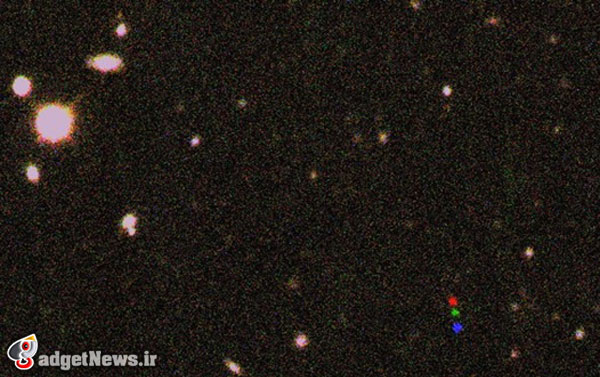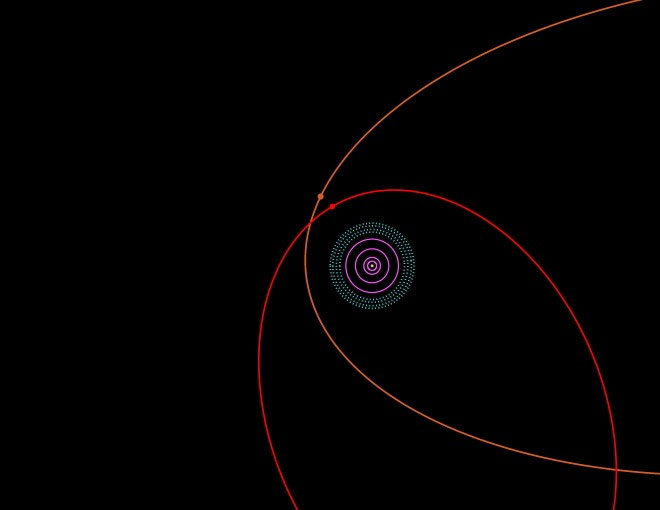
دانشمندان در بنیاد علوم و رصدخانهی جمینی گزارشی را منتشر کردهاند که در آن به اکتشاف یک عضو جدید از منظومهی شمسی اشاره کردهاند. این سیارهی کوتوله که به نام 2012 VP113 شناخته میشود، تصور میشود یکی از اعضای دور ابرهای فرضی Oort داخلی باشد. این سیارهی جدید توسط Scott Sheppard و به کمک یک دوربین مشاهدهی انرژی تاریک در تلسکوپ NOAO شیلی مشاهده شده است که به دانشمندان این قابلیت را میدهد که بتوانند ناحیهی وسیعی از آسمان شب را به دنبال اجسام بسیار کوچک و ریز جستجو کنند.
با اکتشاف 2012 VP113، تیم با استفاده از تلسکوپ 6.5 متری ماژلان به رصد این سیارک پرداختند تا مسیر سیر آن را بیابند. بنابر یافتههای تیم تحقیقاتی، این سیاره در نزدیک ترین حالت حدود 80 AU (یک AU به اندازهی فاصلهی زمین تا خورشید است) از خورشید فاصله دارد. این کشف دومین سیارهای است که تا کنون خارج از کمربند کوییپر یافت شده است. کمربند کوییپر از اجسام یخ زدهای تشکیل شده است که در فاصلهی 30 تا 50 AU از خورشید قرار گرفتهاند و هنوز تحت حاکمیت جاذبهی خورشید قرار دارند.

نمودار گردش سیاره کوتوله 2012 VP113 در مدار
تنها جسم سیارهای دیگری که فراتر از این کمربند تاکنون یافت شده بود Sedna نام داشت که در فاصلهی 50 AU قرار گرفته بود. این سیارهی کوچک تاکنون یکتا تصور میشد، که در نزدیک ترین حالت در فاصلهی 76 AU از خورشید قرار میگرفت، با اکتشاف 2012 VP113 این سیاره نیز از منحصربفرد بودن در آمد.
این اکتشاف جدید مرزهای منظمومهی شمسی ما را گسترش داده است و علاوه بر آن دانستههای ما را در مورد منظومهی شمسی به چالش کشیده است، گویا هنوز چیزهای زیادی برای یادگیری در خصوص منظومهی شمسی خودمان باقی مانده است. هم اکنون مرز نهایی منظومهی شمسی ما به ابرهای Oort داخلی نسبت داده میشود. این ابرها از ابرهای Oort خارجی که در فاصلهی 1500 AU از ما قرار گرفتهاند متمایز میشوند، چراکه ابرهای خارجی به طور مشخص تحت اثر جاذبهی ستارگان دیگر قرار میگیرند. اما ابرهای داخلی به طور مشخص از اثرات این تداخلها به دورند و مدارهای منظم تری را – که البته تحت اثر مستقیم خورشید قرار دارند – دنبال میکنند. تصور میشود که تا حدود بیش از 900 جرم آسمانی در ابرهای داخلی Oort مشابه با 2012 VA113 وجود دارند که هر یک ابعادی حدود 1000 کیلومتری دارند.
برخی از این اجرام ابعادی در حدود مریخ یا حتی زمین دارند اما به دلیل دور بودن بسیار زیاد آنها شناسایی آنها به سختی ممکن است چرا که با فناوری کنونی شناسایی چنین اجرام ضعیفی (منظور فاصله دور است) تاحد زیادی ناممکن است.
تا کنون سه نظریه یکلی در خصوص فواصل بسیار طولانی و ناهمگون 2012 VP113 و Sedna ارائه شده است. در نظریهی اول اعتقاد دارد که در اثر برخورد سیارکهای کوچک سیارهای بسیار بزرگ تشکیل شده است که در نهایت منجر به خروج آن از منظومهی شمسی شده است. در مسیر خروج این سیاره به اجرام کمربند کوییپر برخورد کرده و این منجر به تغییر مسیر و ایجاد مدارهای عجیب در این اجرام شده است، اجرامی که اخیرا نیز کشف شدهاند از این دسته محسوب میشوند. این نظریه اخیرا با توجه به یافتههای جدید ناسا با توجه به دادههای ماهوارهی WISE تاحد زیادی رد شده و شواهدی مبنی بر تایید آن یافت نشده است.
بنابراین این مدارهای عجیب یا میبایست حاصل تداخل جاذبهی سایر ستارگان باشند یا این اجرام پس از شکل گیری – در خارج منظومهی شمسی- نهایتا در طی سفر طولانی خود در دام میدان جاذبهی خورشید افتادهاند. با توجه به یافتههای جدیدی که از ابرهای Oort داخلی با کشف این سیارهی جدید به دست آمده امید میرود که بتوانیم دانستههای خود را در خصوص منظومهی شمسی خود و مدارهای غیرمعمول این اجرام کوچک افزایش دهیم.
منبع : gizmag
Newly-discovered dwarf planet pushes back the edge of the Solar System
Scientists from the Carnegie Institution for Science and the Gemini Observatory have reported the existence of a new member of our solar system. The distant dwarf planet, dubbed 2012 VP113, is believed to be one of thousands of distant objects that make up the hypothesized "inner Oort cloud."
The new planetary body was discovered by Scott Sheppard of Carnegie and Chadwick Trujillo of the Gemini Observatory with the aid of the Dark Energy Camera on the NOAO telescope in Chile. The four meter telescope has the largest field of view of any telescope of its size, allowing the team to scan vast areas of the night sky for objects which are ordinarily too faint to see.
Once 2012 VP113 had been discovered, the team used the Magellan 6.5-meter telescope at Carnegie’s Las Campanas Observatory to ascertain the orbit of the dwarf planet. It was discovered that at its closest point, 2012 VP113 is roughly 80 AU from the sun (with 1 AU being the distance from the Earth to the Sun). This made the new discovery only the second planetary body to be found outside the Kuiper belt, a ring of icy objects 30 to 50 AU from the Sun, yet still under the sway of our star's gravitational pull.
The only other planetary body found to stray beyond the previously accepted 50 AU limit of our solar system was Sedna. This minor planet was believed to be unique, orbiting the Sun with a closest approach of 76 AU, however, with the discovery of 2012 VP113 it is clear that this is not the case.
Therefore, this new discovery has the effect of pushing back the boundaries of our immediate solar system. Linda Elkins-Tanton, director of Carnegie's Department of Terrestrial Magnetism underpinned this when she stated, "This is an extraordinary result that redefines our understanding of our Solar System."
This new hypothesized edge of the Solar System is being referred to as the “inner Oort Cloud.” This cloud differs from the outer Oort cloud as objects in the latter, orbiting from 1500 AU, are constantly affected by the gravity of nearby stars. However, the celestial bodies in the inner Oort cloud are free from such interference and therefore follow a more stable orbit.
It is believed that there are in excess of 900 objects present in the inner Oort cloud with similar orbits to 2012 VA113, some of which may exceed 1,000 km (620 mi) in size.
"Some of these inner Oort cloud objects could rival the size of Mars or even Earth," says Sheppard. "This is because many of the inner Oort cloud objects are so distant that even very large ones would be too faint to detect with current technology."
There are three prevailing theories regarding the cause of the irregular and distant orbits of 2012 VP113 and Sedna. The first theory is that a massive planet roughly ten times the size of Earth was expelled from the ordinary orbit of giant planets. As it made its way out of the immediate Solar System it perturbed objects from the Kuiper belt, causing the irregular orbits of the newly discovered planetary bodies. However, this theory has arguably already been disproved as a recent survey by NASA's Wide-Field Infrared Survey Explorer (WISE) satellite has turned up no evidence of a Super Earth hiding in the fringes of the Solar System.
Therefore, it is most likely that either the irregular orbit is the result of a close encounter with the gravity of another star, or that the new discoveries are in fact extra-solar planets captured by the gravity of our Sun from its birth cluster. It is believed that the discovery of further planets in the hypothesized inner Oort cloud will help to shed light on the irregular orbits of these minor planets.
 گجت نیوز آخرین اخبار تکنولوژی، علم و خودرو
گجت نیوز آخرین اخبار تکنولوژی، علم و خودرو 





